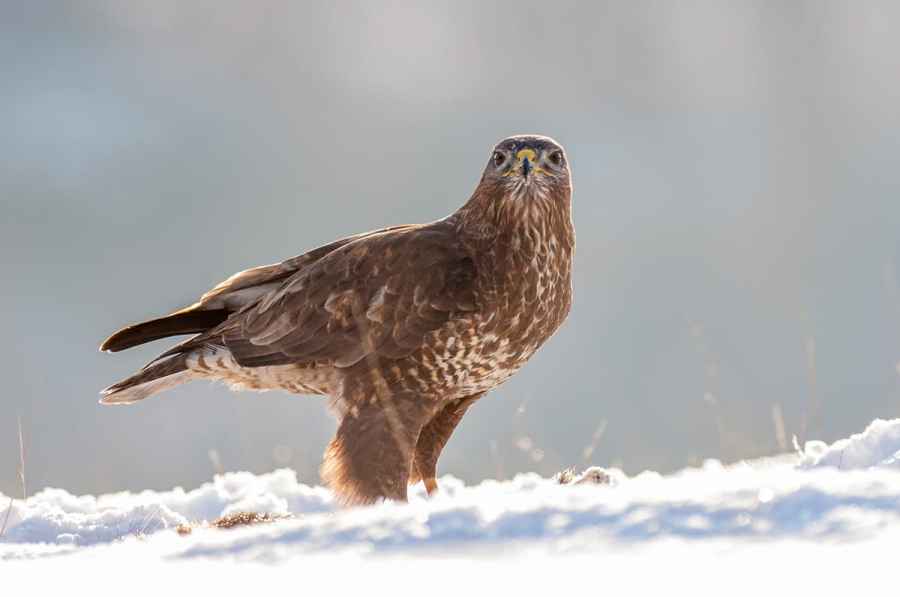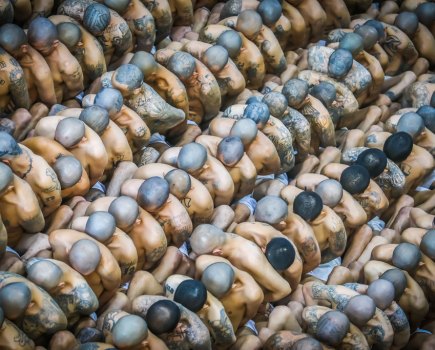In 2009 I fulfilled an ambition I had held for years: to photograph wild common buzzards in my home county of Kent. Why? Well, until 15 years ago they were quite a rare sight here on the North Downs, but over the years they have moved further east, to a point that it’s now unusual not to see one while out on the hills. To my knowledge, there are more than 2,000 breeding pairs in Kent alone, and I know of three nests within a couple of miles of where I live. They may be incredibly common in the west and north, and hardly in the same league as the magnificent golden or white-tailed eagles, but there is just something about them: the way they soar, the way they circle a territory, their call…
In previous years, as I sat in my hide photographing woodland birds at my winter feeding station, the desire would burn deeper to photograph this magnificent bird of prey. With winter just around the corner, I decided to commit the following five months to this project. But, if I were to succeed, everything – and I mean everything – had to be by the book, as raptors are notoriously shy and keen-eyed birds.
The most important factor was not to visit the hide during daylight when buzzards would see me and therefore associate the hide with humans. That would of course make them very reluctant to come down and feed so close. I began by erecting a 1.5m [5ft] square wooden hide at the top of a hill, backed against a hedge. Using just the red lamp on my head torch, the hide was put together on a wet and windy night when I was certain that the birds would be sheltering and wouldn’t notice me setting up. I then didn’t go anywhere near the hide for two weeks.
To entice the buzzards close to my hide on a semi-regular basis I required roadkill, which was stockpiled and stored in my freezer, with kind permission from my extremely understanding partner! A few times a week, pre-dawn, I would place a dead rabbit 30m (100ft) or so from the hide. I’d then return two hours after sunset, and if the rabbit hadn’t been devoured by the birds I would place it up a tree, to avoid it being taken by a fox, and return the following morning to repeat the exercise. I then gradually reduced the distance of the rabbit to the hide to around 15m (50ft).
Throughout much of January we were experiencing cold, frosty conditions. I would enter the hide at 6am (two hours before sunrise) and wouldn’t leave until 6pm. On my first visit, 11 hours later, a buzzard arrived and fed, but the light was too poor to get anything worthy. I was content, however, to just be there, knowing that all my work wasn’t in vain. Over the following days a buzzard did appear in very good light and I managed to get some half-decent images. But something was still missing: that all-important ingredient – snow!
As luck would have it, at the end of that same month we had a substantial amount of snow with very poor visibility, lasting for several days. I needed a break in the weather to entice the buzzards from where they’d been sheltering from the harsh conditions. I then had the forecast I’d been waiting for: a clear day with blue skies all the way. Perfect! This would surely tempt the birds out from the nest to look for food.
I woke at 3am and following a rather treacherous journey in my car through deep snow, made it to my hide in the dark. After this adventure, I should point out that I now have a four-wheel-drive vehicle! I staked down the roadkill to avoid it being carried off by the birds (including magpies), set everything up in the hide, and then sat back and waited.
At about 10am and without warning, a handsome adult buzzard arrived. I dared not take any images for at least a couple of minutes as I wanted to allow it to relax and feed, which it then did for almost half an hour. It took my breath away to be only 15m away from the species of bird I’d been longing to photograph, in the wild, for years.
Later that same day an immature buzzard turned up and, just like the one before, it spent a considerable amount of time feeding, oblivious to the photographer who, at this point, was beaming like a Cheshire cat!
Hide and seek
Sitting motionless for hours on end may not be everyone’s cup of tea, but there are times when there’s no other way of obtaining close views and photographs of a shy species – especially birds of prey. As mentioned, I had to do everything by the book if I wanted to stand any chance of success, and if it didn’t work at least I could be satisfied that I did all I could without causing unnecessary disturbance while in the hide. When waiting for a buzzard to arrive I was always aware that even though I could not see the bird, it could well be watching the hide or perhaps, just sitting in a tree right behind me. A wooden hide muffles some noise, but what may seem barely audible to us could be enough to deter a buzzard from venturing closer. Velcro and Gore-Tex are the devil’s work in nature photography – best avoided – as are noisy wrappers.
I wrapped my sandwiches in paper towel and placed items such as a teleconverter, cable release and spare battery on the hide shelf, which I had covered with felt to avoid any sound as items were used and replaced. Oh yes, a flask of steaming hot tea was also out of the question – for obvious reasons!
Robert Canis
Robert has been a professional nature photographer for more than 20 years. He gives around 20 illustrated talks each year and regularly holds wildlife and landscape photography workshops both in the UK and overseas. He is represented by three international agencies and has been the recipient of numerous awards. www.robertcanis.com







